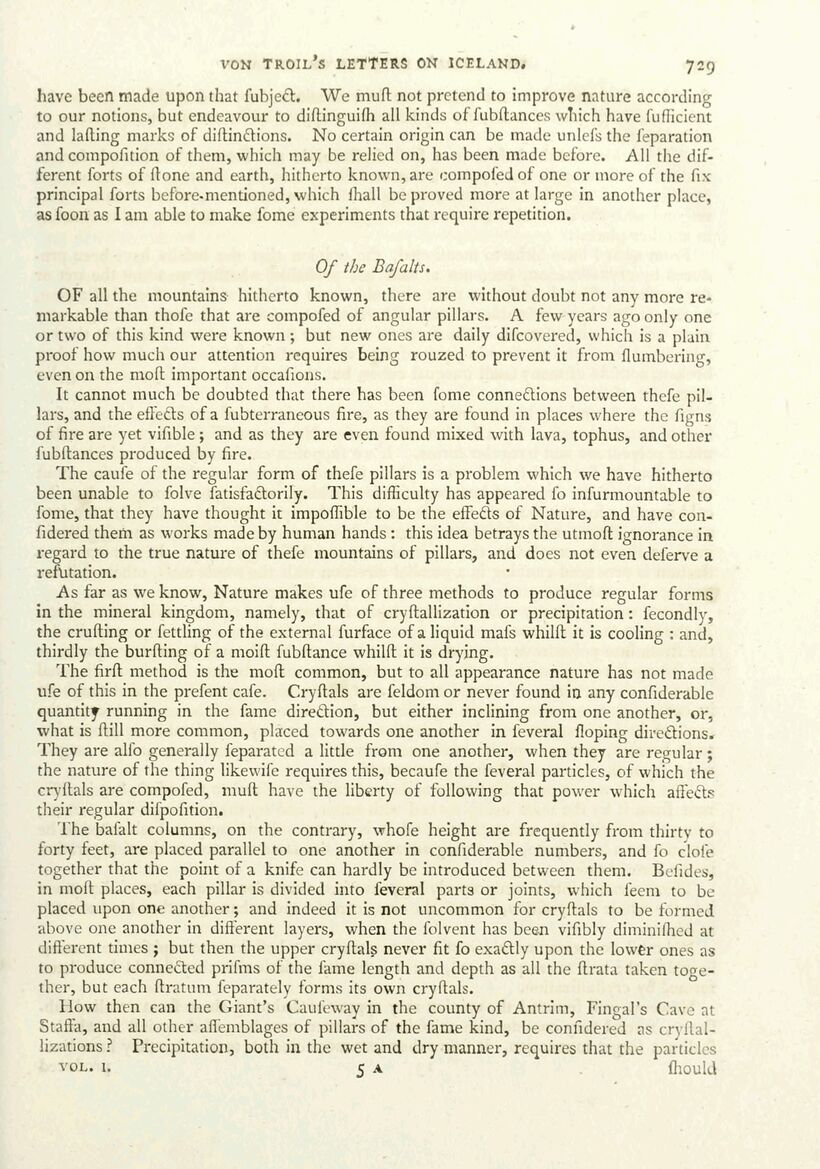
Full resolution (JPEG) - On this page / på denna sida - Pages ...

<< prev. page << föreg. sida << >> nästa sida >> next page >>
Below is the raw OCR text
from the above scanned image.
Do you see an error? Proofread the page now!
Här nedan syns maskintolkade texten från faksimilbilden ovan.
Ser du något fel? Korrekturläs sidan nu!
This page has never been proofread. / Denna sida har aldrig korrekturlästs.
VON TROIL’S LETTERS ON ICELAND, 729
have been made upon that fubje&t. We muft not pretend to improve nature according
to our notions, but endeavour to diftinguith all kinds of fub{tances which have fufficient
and lafting marks of diftinctions. No certain origin can be made unlefs the feparation
and compofition of them, which may be relied on, has been made before. All the dif-
ferent forts of ftone and earth, hitherto known, are compofed of one or more of the fix
principal forts before-mentioned, which fhall be proved more at large in another place,
as foon as Iam able to make fome experiments that require repetition.
Of the Ba/falts.
OF allthe mountains hitherto known, there are without doubt not any more re-
markable than thofe that are compofed of angular pillars. A few years ago only one
or two of this kind were known; but new ones are daily difcovered, which is a plain
proof how much our attention requires being rouzed to prevent it from flumbering,
even on the moft important occafions.
It cannot much be doubted that there has been fome connections between thefe pil-
lars, and the effects of a fubterraneous fire, as they are found in places where the figns
of fire are yet vifible; and as they are even found mixed with lava, tophus, and other
fubftances produced by fire.
The caufe of the regular form of thefe pillars is a problem which we have hitherto
been unable to folve fatisfactorily. This difficulty has appeared fo infurmountable to
fome, that they have thought it impoflible to be the effects of Nature, and have con-
fidered them as works made by human hands: this idea betrays the utmoft ignorance in
regard to the true nature of thefe mountains of pillars, and does not even deferve a
refutation. :
As far as we know, Nature makes ufe of three methods to produce regular forms
in the mineral kingdom, namely, that of cryftallization or precipitation: fecondly,
the crufting or fettling of the external furface of a liquid mafs whillt it is cooling : and,
thirdly the burfting of a moift fubftance whilft it is drying.
The firft method is the moft common, but to all appearance nature has not made
ufe of this in the prefent cafe. Cryftals are feldom or never found in any confiderable
quantity running in the fame direction, but either inclining from one another, or,
what is {till more common, placed towards one another in feveral floping direétions.
They are alfo generally feparated a little from one another, when they are regular ;
the nature of the thing likewife requires this, becaufe the feveral particles, of which the
cry{ftals are compofed, muft have the liberty of following that power which affeéts
their regular difpofition.
The bafalt columns, on the contrary, whofe height are frequently from thirty to
forty feet, are placed parallel to one another in confiderable numbers, and fo clofe
together that the point of a knife can hardly be introduced between them. Befides,
in moft places, each pillar is divided into feveral parts or joints, which feem to be
placed upon one another; and indeed it is not uncommon for cryftals to be formed
above one another in different layers, when the folvent has been vifibly diminifhed at
different times ; but then the upper cryftals never fit fo exactly upon the lower ones as
to produce connected prifms of the fame length and depth as all the ftrata taken toge-
ther, but each ftratum feparately forms its own cryftals.
How then can the Giant’s Caufeway in the county of Antrim, Fingal’s Cave at
Staffa, and all other aflemblages of pillars of the fame kind, be confidered as cryftal-
lizations? Precipitation, both in the wet and dry manner, requires that the particles
VOL. lL. iw fhould
<< prev. page << föreg. sida << >> nästa sida >> next page >>